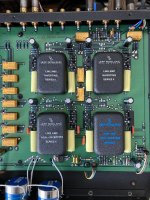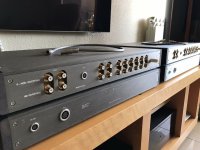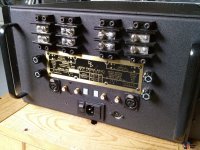I've a pair of Pass mono's which I like to use with an old pre-amp which has a balanced out but not with a XLR chassispart but with two female RCA chassisparts


Do I have to solder it myself or are there already products available for these conversions?
Krell KRS-1B had also a balanced output with two RCA chassisparts instead of a XLR chassispart:



Do I have to solder it myself or are there already products available for these conversions?
Krell KRS-1B had also a balanced output with two RCA chassisparts instead of a XLR chassispart:

You could use just one side into the unbalanced input of the pass.I've a pair of Pass mono's which I like to use with an old pre-amp which has a balanced out but not with a XLR chassispart but with two female RCA chassispartsView attachment 1098394View attachment 1098396
Do I have to solder it myself or are there already products available for these conversions?
Krell KRS-1B had also a balanced output with two RCA chassisparts instead of a XLR chassispart:
View attachment 1098401
You want something like this?
https://www.amazon.com/Splitter-Unb...Adapter/dp/B083R4GSCK/ref=asc_df_B083R4GSCK/?
https://www.amazon.com/Splitter-Unb...Adapter/dp/B083R4GSCK/ref=asc_df_B083R4GSCK/?
Is this really a balanced output? Or is it just two single ended outputs with inverterd polarity, but referenced to audio GND?
If the RCAs are referenced to audio GND, it will be tricky to connect XLR pin-1 to the chassis.
If the RCAs are referenced to audio GND, it will be tricky to connect XLR pin-1 to the chassis.
if pass monos ( you didn't said which ones) are having proper balanced inputs, then you need set of custom made interconnects, each channel cable made of 2 RCA plugs on one side and one male XLR on other side
blame Krell for that
now channel cable made of :
RCA connector 1 plugged in positive phase socket on preamp, gnd connected to pin 1 on XLR on other side of cable, hot connected to pin 2 on XLR other side of cable
RCA connector 2 plugged in negative phase socket on preamp, gnd connected to pin 1 on XLR on other side of cable, hot connected to pin 3 on XLR other side of cable
you need two same cables for stereo
blame Krell for that
now channel cable made of :
RCA connector 1 plugged in positive phase socket on preamp, gnd connected to pin 1 on XLR on other side of cable, hot connected to pin 2 on XLR other side of cable
RCA connector 2 plugged in negative phase socket on preamp, gnd connected to pin 1 on XLR on other side of cable, hot connected to pin 3 on XLR other side of cable
you need two same cables for stereo
The small image in the ad says it is wired like this:something like this?

Not what we want?
That IS a "balanced output". Could be a transformer with grounded center-tap. It is not a "floating output".Is this really a balanced output? Or is it just two single ended outputs with inverterd polarity, but referenced to audio GND?
I know there's a provision for that but I believe if I use the normal (non-inverted) or inverted output of my pre-amp I will dispense with the benefits that Jeff Rowland describes as 'Differential Mode' and Nelson Pass as Supersymmetry.You could use just one side into the unbalanced input of the pass.
No I do not think so. It's what member PRR also suggests and as you can see both RCA pins are connected to pin 2 positive polarity of the XLR and pin 3 iis shorted with ground to pin 1. That's still a single-ended configuration.You want something like this?
https://www.amazon.com/Splitter-Unb...Adapter/dp/B083R4GSCK/ref=asc_df_B083R4GSCK/?
If you see the circuitry of the JR pre-amp you see the Lef & Right modules for the normal and inverted portion of the line-out signal. Jeff Rowland issued a paper around the late eighties called 'Differential Mode Technology' where he discusses the benefits of basically noise cancellation by proper implementation of this technique in a symmetrical configuration. This paper is included in the manual of my pre-amp so I assume it's a true balanced output circuitry but with two female RCA chassisparts and not one XLR output.Is this really a balanced output? Or is it just two single ended outputs with inverterd polarity, but referenced to audio GND?
If the RCAs are referenced to audio GND, it will be tricky to connect XLR pin-1 to the chassis.
His early power amps, like the Krell KRS's provided the use of two RCA cables per channel (next to a XLR connector) to get a balanced connection with my pre-amp:

This particular stereo power amplifier the Model 5 was used with the Coherence One pre-amp I have but the acquirer of this combo threw it away like garbage along with a pair of Apogee Duetta signatures not knowing what to do with it...
I've the 600.5's which have both a balanced (XLR) and single-ended provision which my former Pass amps the X600's which only have a balanced setup with a XLR connector.if pass monos ( you didn't said which ones) are having proper balanced inputs, then you need set of custom made interconnects, each channel cable made of 2 RCA plugs on one side and one male XLR on other side
blame Krell for that
now channel cable made of :
RCA connector 1 plugged in positive phase socket on preamp, gnd connected to pin 1 on XLR on other side of cable, hot connected to pin 2 on XLR other side of cable
RCA connector 2 plugged in negative phase socket on preamp, gnd connected to pin 1 on XLR on other side of cable, hot connected to pin 3 on XLR other side of cable
you need two same cables for stereo
Regarding to your instruction how to make such a cable that's the way to accomplish it but I hoped that I could get a confection cable because my soldering skills are just awful... Thanks for that.
I will 😉Our balanced inputs are very flexible. Just treat pin 1 as ground.
if pass monos ( you didn't said which ones) are having proper balanced inputs, then you need set of custom made interconnects, each channel cable made of 2 RCA plugs on one side and one male XLR on other side
blame Krell for that
now channel cable made of :
RCA connector 1 plugged in positive phase socket on preamp, gnd connected to pin 1 on XLR on other side of cable, hot connected to pin 2 on XLR other side of cable
RCA connector 2 plugged in negative phase socket on preamp, gnd connected to pin 1 on XLR on other side of cable, hot connected to pin 3 on XLR other side of cable
you need two same cables for stereo
Great editing work that's how it should be done. Maybe pin 1 to one the outer jackets is sufficient for ground?
when there is no critical details in construction, and in PL there is not, pin 1 or sleeve, is pretty much the same
I ment pin 1 XLR to one of the outer sleeves of the RCA connectorswhen there is no critical details in construction, and in PL there is not, pin 1 or sleeve, is pretty much the same
that, yes
pretty much all depends how OP is going to make that cable
I would use two single coax cables , each leading from one RCA and both going to XLR
sleeves connected to RCA GNDs, both sleeves to XLR pin 1
even if you have loop that way, it is closed and acting as proper shield for both RCA hots
pretty much all depends how OP is going to make that cable
I would use two single coax cables , each leading from one RCA and both going to XLR
sleeves connected to RCA GNDs, both sleeves to XLR pin 1
even if you have loop that way, it is closed and acting as proper shield for both RCA hots
Clear, I will try to find a way to squeeze them into a XLR connector housing,that, yes
pretty much all depends how OP is going to make that cable
I would use two single coax cables , each leading from one RCA and both going to XLR
sleeves connected to RCA GNDs, both sleeves to XLR pin 1
even if you have loop that way, it is closed and acting as proper shield for both RCA hots
RobertS61:
I owned a Jeff Rowland Coherence One (initially a Series 1 which was soon updated to a series 2) for almost 20 years and thought it was exceptional. Grainless, great soundstage, wonderfully resolving, lovely phono stage, sleek and very reliable. The attenuator (Penny and Giles, I believe) was terrific. I only used it in a single-ended system. Then I built an Aleph P and found myself more deeply immersed in the music. Zen Mod's guidance is spot on, but with all due respect you would also do well to consider a new preamplifier.
Regards,
Scott
I owned a Jeff Rowland Coherence One (initially a Series 1 which was soon updated to a series 2) for almost 20 years and thought it was exceptional. Grainless, great soundstage, wonderfully resolving, lovely phono stage, sleek and very reliable. The attenuator (Penny and Giles, I believe) was terrific. I only used it in a single-ended system. Then I built an Aleph P and found myself more deeply immersed in the music. Zen Mod's guidance is spot on, but with all due respect you would also do well to consider a new preamplifier.
Regards,
Scott
Hi Scott,RobertS61:
I owned a Jeff Rowland Coherence One (initially a Series 1 which was soon updated to a series 2) for almost 20 years and thought it was exceptional. Grainless, great soundstage, wonderfully resolving, lovely phono stage, sleek and very reliable. The attenuator (Penny and Giles, I believe) was terrific. I only used it in a single-ended system. Then I built an Aleph P and found myself more deeply immersed in the music. Zen Mod's guidance is spot on, but with all due respect you would also do well to consider a new preamplifier.
Regards,
Scott
Yes indeed, this pre-amp is 32 years old but I'm struggling a bit with the pre-amp compartment.
I have a Spectral DMC-20 with phono, a Spectral DMC-10 Delta (standard with phono) a Pass X2 line only, a Threshold FET 11G line only and this Coherence One Series II. I don't like streaming, do like CD's and have a kind of love hate affair with records which was my only source till I bought my first Wadia.
I do have good memories about the Rowland C1 and M7 setup I once had especially for phono but maybe I should leave these where they belong in the past,,,
Wish there was a good modern pre-amp with flexible onboard phono, balanced in and out (with XLR's ;-)).
- Home
- Amplifiers
- Pass Labs
- Old pre-amp on Pass Labs mono's